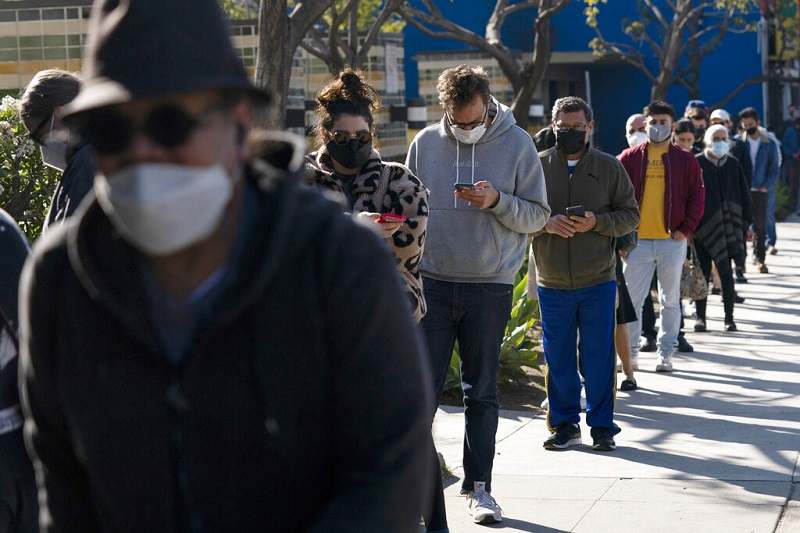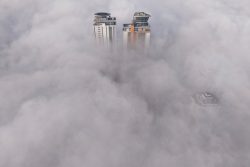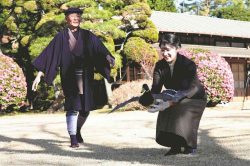
FILE – People wait in line for a COVID-19 test in Los Angeles, Tuesday, Jan. 4, 2022. Sixty-three percent of Black Americans and 68% of Hispanic Americans say they are at least somewhat worried about themselves or a family member being infected with COVID-19, compared to 45% of white Americans, according to an April poll from The Associated Press-NORC Center for Public Affairs Research.
14:46 JST, April 30, 2022
Black and Hispanic Americans remain far more cautious in their approach to COVID-19 than white Americans, recent polls show, reflecting diverging preferences on how to deal with the pandemic as federal, state and local restrictions fall by the wayside.
Despite majority favorability among U.S. adults overall for measures like mask mandates, public health experts said divided opinions among racial groups reflect not only the unequal impact of the pandemic on people of color but also apathy among some white Americans.
Black Americans (63%) and Hispanic Americans (68%) continue to be more likely than white Americans (45%) to say they are at least somewhat worried about themselves or a family member being infected with COVID-19, according to an April poll from The Associated Press-NORC Center for Public Affairs Research.
Throughout the pandemic, Black and Hispanic communities have experienced higher rates of illness and death from COVID, said Amelia Burke-Garcia, public health program area director at NORC. Those experiences have resulted in greater levels of stress, anxiety and awareness of the risks of catching COVID-19, she said, which means people of color are more likely to feel measures like mask mandates are needed.
“We’ve seen these trends endure throughout the entire pandemic,” Burke-Garcia said. “What we’re seeing now as mitigation measures are being rolled back is there’s still great concern amongst Black Americans and Hispanic Americans around the risk of getting sick.”
Seventy-one percent of Black Americans say they favor requiring face masks for people traveling on airplanes, trains and other types of public transportation. That’s more than the 52% of white Americans who support mask mandates for travelers; 29% of white Americans are opposed. Among Hispanic Americans, 59% are in favor and 20% are opposed. The poll was conducted before a ruling by a federal judge scuttled the government’s mask mandate for travelers.
In Indiana, Tuwanna Plant said she sees fewer and fewer people wearing masks in public, even though she said she has been diligent in always wearing one. Plant, who is Black, said she sees people treating the pandemic like it’s over, and she wants the mask mandate to continue.
Plant, a 46-year-old sous chef, said she had some concerns about getting the vaccine and took every other precaution, such as cleaning and masking, to avoid getting sick but recently was hospitalized for COVID-19.
The experience scared her — she has a preexisting lung condition, and knew family members who died from COVID-19. She said she plans to get vaccinated as soon as she can.
“I called my children while I was in the emergency room,” Plant said. “I didn’t know … if it was going to get better or worse, I didn’t know. So it was the experience for me altogether.”
Dr. Celine Gounder, an infectious disease specialist and epidemiologist and editor-at-large at Kaiser Health News, said people’s lived experiences deeply shape how they perceive the pandemic. Anecdotes and personal experience can have a larger impact on behavior than numbers, she said, and people of color are more likely to have had negative experiences with health care prior to and during the pandemic.
While new medicines and vaccines have made it easier to treat COVID-19, Gounder said many people still face systemic barriers to accessing that medical care. Others risk losing their jobs or are unable to take time off if they do fall ill, she said, or cannot avoid things like public transit to reduce their exposures.
“When people argue that they don’t have to mask on the plane, that means something very different for someone who has access to all of these new innovations than it does for somebody who has no health insurance, who struggles to care for an elderly parent and their children, who’s maybe a single mom working in a job where she has no paid sick and family medical leave,” Gounder said. “It’s just a completely different calculation.”
In January, an AP-NORC poll showed Black and Hispanic Americans were more likely than white Americans to feel certain things would be essential for getting back to life without feeling at risk of infection. For example, 76% of Black Americans and 55% of Hispanic Americans said it was essential for getting back to normal that most people regularly wear face masks in public indoor places, compared with 38% of white Americans.
Last month, an AP-NORC poll showed Black and Hispanic Americans, 69% and 49%, were more likely than white Americans, 35%, to say they always or often wear a face mask around others.
Lower support for mask mandates and other precautions among white Americans may also reflect less sensitivity towards what occurs in communities of color. In a 2021 study of mask wearing during the early part of the pandemic, researchers found that mask wearing among white people increased when white people were dying at greater rates in the surrounding community. When Black and Hispanic people were dying, mask usage was lower.
Berkeley Franz, a co-author of the paper, said that in addition to residential segregation that separates white people from communities of color, past research has shown that white people can display ambivalence toward policies that they believe mostly help people of color.
“Anti-Blackness is really pervasive and has tremendous consequences, both in terms of the policies that get passed, and what doesn’t,” Franz said. “White people can still have really racist actions without seeing themselves that way and understanding the consequences. It’s largely below the surface and unintentional but has tremendous consequences in terms of equity.”
Communities of color also have a different perception of risk from the pandemic than their white counterparts, said Michael Niño, a sociology professor at the University of Arkansas who co-authored a paper on race, gender and masking in the pandemic.
“Masking is something that is relatively cheap, it’s effective, and it’s something that can be easily done,” he said. “It doesn’t require any sort of governmental response. These broader histories of racism and sexism in the United States are most certainly shaping some of the patterns we’re seeing.”
___
The AP-NORC poll of 1,085 adults was conducted April 14-18 using a sample drawn from NORC’s probability-based AmeriSpeak Panel, which is designed to be representative of the U.S. population. The margin of sampling error for all respondents is plus or minus 3.9 percentage points.
___
Ma covers education and equity for AP’s Race and Ethnicity team. Follow her on Twitter: https://www.twitter. Fingerhut, an AP polling writer, is based in Washington.
The Associated Press’ reporting around issues of race and ethnicity is supported in part by the Howard Hughes Medical Institute’s Department of Science Education. The AP is solely responsible for all content.
"News Services" POPULAR ARTICLE
-

American Playwright Jeremy O. Harris Arrested in Japan on Alleged Drug Smuggling
-

Japan’s Nikkei Stock Average as JGB Yields, Yen Rise on Rate-Hike Bets
-

Japan’s Nikkei Stock Average Licks Wounds after Selloff Sparked by BOJ Hike Bets (UPDATE 1)
-

Japanese Bond Yields Zoom, Stocks Slide as Rate Hike Looms
-

Japan’s Nikkei Stock Average Buoyed by Stable Yen; SoftBank’s Slide Caps Gains (UPDATE 1)
JN ACCESS RANKING
-

Keidanren Chairman Yoshinobu Tsutsui Visits Kashiwazaki-Kariwa Nuclear Power Plant; Inspects New Emergency Safety System
-

Imports of Rare Earths from China Facing Delays, May Be Caused by Deterioration of Japan-China Relations
-

Japan Pulls out of Vietnam Nuclear Project, Complicating Hanoi’s Power Plans
-

Govt Aims to Expand NISA Program Lineup, Abolish Age Restriction
-

Blanket Eel Trade Restrictions Rejected

























